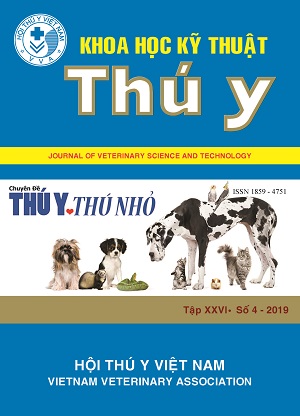Bệnh hệ tiết niệu trên chó tiểu đường lâm sàng
Abstract
This study was carried out on 70 clinical diabetic dogs raising in Can Tho city from June 2015 to December 2017. The objective of this study aimed at determining some renal diseases in the clinical diabetic dogs. All clinical diabetic dogs were specified for urine test to determine the urinary diseases. Urine was collected through a catheter, through the urethra or directly in the urinal. Part 1: 10 ml of urine were poured into the test tube to check transparency, color, and odor; after that, the URS 10 test stick was put into urine in the test tube about 1 second and the color changes were recorded by times. Part 2: 10 ml of urine were poured into the test tube for centrifuging and collecting sediments, then the sediments were observed under the optical microscope with magnification of X40 and X100. The studied results showed that there were 21.43 % of dogs suffered with acute renal failure; 30% of dogs suffered with chronic renal failure, 48.57% of dogs were infected with cystitis. The clinical symptoms of these diseases included anorexia and yellowish brown urine (21.43%); painful kidney, blander, vomiting and polyuria (30%); pale mucosa, polyuria and comatose state (21.43%), hematuria and pus in urine (27.14%). Most of the clinical diabetic dogs with renal diseases had un-normal urine physiological, biochemical and sediment indicator. The rate of disease dogs having un-normal urine sediment indicators, included epithelial blander (25.71%); nephron cells and pyelonephron cells (22.86%); red blood cells (11.3%); white blood cells (44.29%), mixed granular cast (30%), waxy cast (21.43%); some kind of crystals (12.86%)

